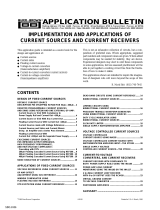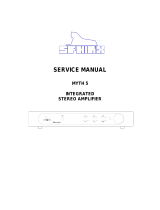Page is loading ...

1
Application Bulletin Number 64
®
©
1994 Burr-Brown Corporation AB-064 Printed in U.S.A. January, 1994
DIODE-CONNECTED FET PROTECTS OP AMPS
Providing input-overload protection for sensitive measure-
ment circuits proves difficult when you must not degrade the
circuits’ performance in the process. It’s an especially tricky
problem when you’re measuring a material’s dielectric prop-
erties. In such an application (see Figure 1), an ultra-low
input bias current op amp serves as a current integrator to
measure a dielectric’s response to a 100V step.
that limits the differential input to 0.6V if the dielectric
shorts. Resistor R
l
limits the maximum short-circuit current
to the 50mA level specified in the FET’s data sheet. R
l
’s
effect on measurement accuracy is negligible because the
dielectric’s impedance is very much greater than the resistor’s
2kΩ value.
JFET LEAKAGE CURRENTS can be so low that they don't degrade a low-
input bias op amp's parameters. Measurements show that Siliconix's 2N4117A
can serve as a voltage limiter when it's diode-connected. The actual leakage
is probably somewhat lower than measured, but thermal effects and noise
place a limiting threshold on the measurement.
0 5 10 15 20 25
V
DG
(V)
Gate Leakage Current (fA)
10
60
70
80
90
100
200
V
DS
= 0V
Thermal and
Noise Threshold
The information provided herein is believed to be reliable; however, BURR-BROWN assumes no responsibility for inaccuracies or omissions. BURR-BROWN assumes
no responsibility for the use of this information, and all use of such information shall be entirely at the user’s own risk. Prices and specifications are subject to change
without notice. No patent rights or licenses to any of the circuits described herein are implied or granted to any third party. BURR-BROWN does not authorize or warrant
any BURR-BROWN product for use in life support devices and/or systems.
Reprinted from EDN, October 5, 1980;
©1980, Cahners Publishing Company.
OPA
R
1
2kΩ
Step
Output
2N4117A
G
DS
OVERVOLTAGE PROTECTION results when you incorporate a diode-
connected JFET in the measuring circuit. If the dielectric shorts during
testing, the FET clamps at 0.6V saving the sensitive op amp from destruc-
tion. R
1
's resistance—although high enough to protect the FET against
overcurrent failure—is still so small relative to the dielectric's impedance that
it doesn't impair measurement accuracy.
FIGURE 3. Overvoltage Protection Circuit.
FIGURE 2. Curve of Leakage Current vs Voltage.
STANDARD DIELECTRIC-EVALUATION SCHEMES can prove disas-
trous to the op amp they employ. If the dielectric under test shorts, the
resulting high voltage at the op amp’s input destroys the device unless the
device’s very-low-bias (low voltage) input stage is somehow protected. The
solution is difficult: Whatever you do, it must not degrade the op amp’s
performance.
FIGURE 1. Dielectric Evaluation Circuit.
OPA
C
Dielectric
Sample
100V
Step Input
V
OUT
= 1/C ∫ idt
i
Unfortunately, the op amp is destroyed if the dielectric
sample shorts.
For one such measurement setup, low-bias current op amps
like the OPA111, OPA121, OPA128, OPA124 or OPA129
can serve because their bias current is in the pA or even fA
range and therefore contributes negligible measurement er-
ror. What type of protective device doesn’t degrade this op
amp’s parameters? PN-junction devices usually have leak-
age currents in the nanoamp range even at very-low bias
voltages—a degradation of several orders of magnitude.
FETs are generally much better in this respect, and Siliconix’s
2N4117A JFET proves the best.
Figure 2 shows an experimentally derived curve of leakage
current vs voltage for this device. Note that for voltages
comparable to those between an op amp’s inputs, the
2N4117A’s leakage is compatible with the op amp’s bias.
(The residual 60fA level at 0V arises from thermal effects
and measurement-system noise.)
The overload-protected design resulting from these FET
measurements is shown in Figure 3. The diode-connected
JFET serves as a shunt across the op amp’s input—a scheme
SBOA058

IMPORTANT NOTICE
Texas Instruments and its subsidiaries (TI) reserve the right to make changes to their products or to discontinue
any product or service without notice, and advise customers to obtain the latest version of relevant information
to verify, before placing orders, that information being relied on is current and complete. All products are sold
subject to the terms and conditions of sale supplied at the time of order acknowledgment, including those
pertaining to warranty, patent infringement, and limitation of liability.
TI warrants performance of its semiconductor products to the specifications applicable at the time of sale in
accordance with TI’s standard warranty. Testing and other quality control techniques are utilized to the extent
TI deems necessary to support this warranty. Specific testing of all parameters of each device is not necessarily
performed, except those mandated by government requirements.
Customers are responsible for their applications using TI components.
In order to minimize risks associated with the customer’s applications, adequate design and operating
safeguards must be provided by the customer to minimize inherent or procedural hazards.
TI assumes no liability for applications assistance or customer product design. TI does not warrant or represent
that any license, either express or implied, is granted under any patent right, copyright, mask work right, or other
intellectual property right of TI covering or relating to any combination, machine, or process in which such
semiconductor products or services might be or are used. TI’s publication of information regarding any third
party’s products or services does not constitute TI’s approval, warranty or endorsement thereof.
Copyright 2000, Texas Instruments Incorporated
/

